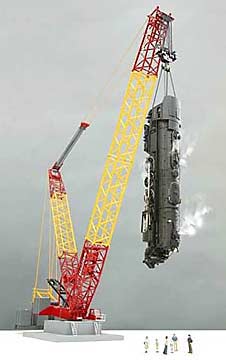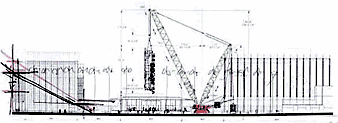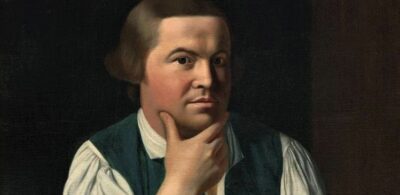Jeff Koons: The Schlock of the New
On February 1st, 2007, Los Angeles Country Museum of Art CEO Michael Govan and postmodernist “King of Kitsch” Jeff Koons, were featured speakers at a LACMA public event billed as a conversation on “the role of artists in shaping the museum of the future.” At the event the duo publicly announced plans to erect Koons’ Train, an enormous structure made of an actual 70-foot fabricated steam locomotive hanging from a massive 161-foot heavy construction crane.
To be located at LACMA’s “BP Grand Entrance” on Wilshire Boulevard, the suspended train will spin its wheels, whistle and blow-out steam three times a day; and according to Govan, “The beautiful thing is that we would see it from the 10 freeway and from downtown” – which to those not familiar with L.A. means the structure will be visible from most points in the sprawling metropolis. New York Arts Magazine reported that Govan compared the project to the Eiffel Tower, “expressing hope that the piece would become a landmark for Los Angeles.”

If Train reminds you of the works created by the Dadaists or Surrealists, or perhaps the readymades constructed by Marcel Duchamp – think again. The aforementioned were outsiders who used art to blow-up the traditions and power centers of the elite art world. Koons on the other hand is an insider who is wedded to privilege, as is evident from the $1 million given to LACMA by the Annenberg Foundation, funds to be used in conducting engineering studies on the feasibility of Koons’ proposed construction. Train also has the backing of billionaire and LACMA trustee Eli Broad, who has donated $60 million to LACMA for the construction of The Broad Contemporary Art Museum – which by the way will house Broad’s collection of twenty Jeff Koons originals.
Those who attempt to find anything meaningful in Koons’ productions should simply remember the following admonition from him, “A viewer might at first see irony in my work… but I see none at all. Irony causes too much critical contemplation.” There you have it, the perfect art for 21st century America – it won’t make you think! However, there is great irony in Train – though certainly Koons, Govan, Broad, and their supporters are hopelessly unaware of this. The U.S. passenger train and light-rail industry was effectively destroyed through the combined rise of private automobiles, diesel buses, the development of an Interstate Highway System, and the use of trucks and planes for freight transport. Naturally, oil companies and their supporting industries benefited enormously from this shift. The irony is that in order to see Koons’ ludicrous steam locomotive one must first pass through the “BP Grand Entrance” – LACMA’s paean to the power and glory of big oil. Though unintentional, Koons’ Train gives us a representation of the U.S. passenger train industry crucified by the might of the petroleum empire.
More than 25 years ago, art critic Robert Hughes helped to change the way people thought about modern art through his TV series, The Shock of the New. The series was revised by Hughes in 2004 to reflect current realities, and broadcast on the BBC that same year as, The New Shock of the New. Here’s what Hughes had to say about Koons:
“We decided to put Jeff Koons in the new programme: not because his work is beautiful or means anything much, but because it is such an extreme and self-satisfied manifestation of the sanctimony that attaches to big bucks. Koons really does think he’s Michelangelo and is not shy to say so. The significant thing is that there are collectors, especially in America, who believe it. He has the slimy assurance, the gross patter about transcendence through art, of a blow-dried Baptist selling swamp acres in Florida. And the result is that you can’t imagine America’s singularly depraved culture without him. He fits into Bush’s America the way Warhol fitted into Reagan’s. There may be worse things waiting in the wings (never forget that morose observation of Milton’s on the topography of Hell: “And in the lowest depth, a lower depth”) but for the moment they aren’t apparent, which isn’t to say that they won’t crawl, glistening like Paris Hilton’s lip-gloss, out of some gallery next month. Koons is the perfect product of an art system in which the market controls nearly everything, including much of what gets said about art.”
Condemnation of Koons abounds, but one of the finest critiques made of him and what he represents, can be find in D.S. Baker’s February 1993 article, Jeff Koons And The Paradox Of A Superstar’s Phenomenon, a must read for anyone interested contemporary art:
“As Superstar, as real capitalist (a former stockbroker), as real playboy with sex object (see Koons’ series Made in Heaven), Koons inverts Warhol’s position. Instead of being the alienated artist who mimics commodity relations, Koons himself becomes an authentic reified creation, a Superstar. In doing so, he negates any distance from celebrity and the culture industry. Where Warhol could merely declare that he was all surface, it is Koons who officially becomes homogeneous with commodity society – pure surface. Rather than making art from some as-yet-unincorporated enclave, Koons is making art from within the structures of institutional art, as part and parcel of the culture industry.”
The above excerpt from Baker’s article mentioned the series, Made in Heaven, which in my opinion is the best introduction to a vapid artist steeped in narcissism and shallowness. In 1991 Koons married Italian porn-star turned politician, Ilona Staller. Being a shameless self-publicist, Koons had himself photographed naked with his wife engaged in uninhibited sex – the stills becoming the basis for the artist’s Made in Heaven suite of paintings and sculptures. Koons’ had the photos printed in oil based inks on canvas, and insists these abominations are “paintings.” No doubt Billionaire tycoons Eli Broad and François Pinault – who have made the works of Koons a cornerstone of their collections – would agree (You can see the Made in Heaven series here – but be careful, adults only!) In a 1986 interview conducted with the Journal of Contemporary Art, Koons was asked what he thought of advertising, since his works are largely based upon corporate media images, Koons responded:
“It’s basically the medium that defines people’s perceptions of the world, of life itself, how to interact with others. The media defines reality. Just yesterday we met some friends. We were celebrating and I said to them: ‘Here’s to good friends!’ It was like living in an ad. It was wonderful, a wonderful moment. We were right there living in the reality of our media (…) I believe in advertisement and media completely. My art and my personal life are based in it.”
Koons supposedly represents the “best and brightest” from the national cultural scene – a sad “fact” I find utterly disheartening and unacceptable. That LACMA can reward this cipher with a high-profile commission and a place in art history does not bode well for any of us. Robert Pincus-Witten, director of exhibitions at C&M Arts, put it this way; “Jeff recognizes that works of art in a capitalist culture inevitably are reduced to the condition of commodity. What Jeff did was say, ‘Let’s short-circuit the process. Let’s begin with the commodity.'” In other words – to hell with art, let’s make money.

Another troubling aspect to Koons being placed front and center at the new LACMA is the effect Train will have on the overall look of the museum, giving it the aura of a commercial entertainment theme park like Hollywood’s Universal Citywalk, confirming the clichés people have about culture in a place like Los Angeles. Dutch architect Rem Koolhaas was initially selected to redesign the museum, but when his plans proved too costly, he was fired and replaced by the Italian architect Renzo Piano. As Piano drew up plans for the renovated museum, LACMA’s director Michael Govan began to interject his own ideas for the look and feel of the revamped institution – bringing the wretched Koons into the picture. L.A. Times staff writer Christopher Hawthorne correctly but politely referred to this as “pulling focus” from Piano’s graceful designs. Hawthorne wrote that Koons’ Train carries:
“…heavy symbolic weight and a sensibility that couldn’t be more different from Piano’s work. The architect’s recent projects stress rationality, the careful manipulation of light and a seamless, elegant marriage of technology and design. The train, which hangs perpendicular to the ground, seems to be hurtling straight at the pavement, ready to smash all those ideas to bits. In part – and there is really no getting around this fact – the new elements also serve to camouflage Piano’s architecture.”
Koons is deficient in his capacity to draw, paint, or sculpt – and like many other postmodernists, he contracts others to actually create his artworks. The manufacture of his objects is handled by a small army of studio assistants at his outfit, Jeff Koons Productions. In the previously mentioned Journal of Contemporary Art interview, he admitted that “I’m basically the idea person. I’m not physically involved in the production. I don’t have the necessary abilities.” Apologists for this type of art production say that its no different than the medieval or renaissance art workshops where apprentices labored under the direction of a master artist; but while the masters of old delegated certain tasks to other artists or assistants, they were more than mere directors, they were intimately involved in the actual work. That could even be said for a modern like Andy Warhol and his factory. The lowliest paint mixer in a renaissance workshop would have been a better draftsman than Koons – but these days, not having the “necessary abilities” is no impediment to becoming an art star with a lucrative career. Nevertheless, Koons is no master artist, and it is an embarrassment that LACMA actively promotes him.


